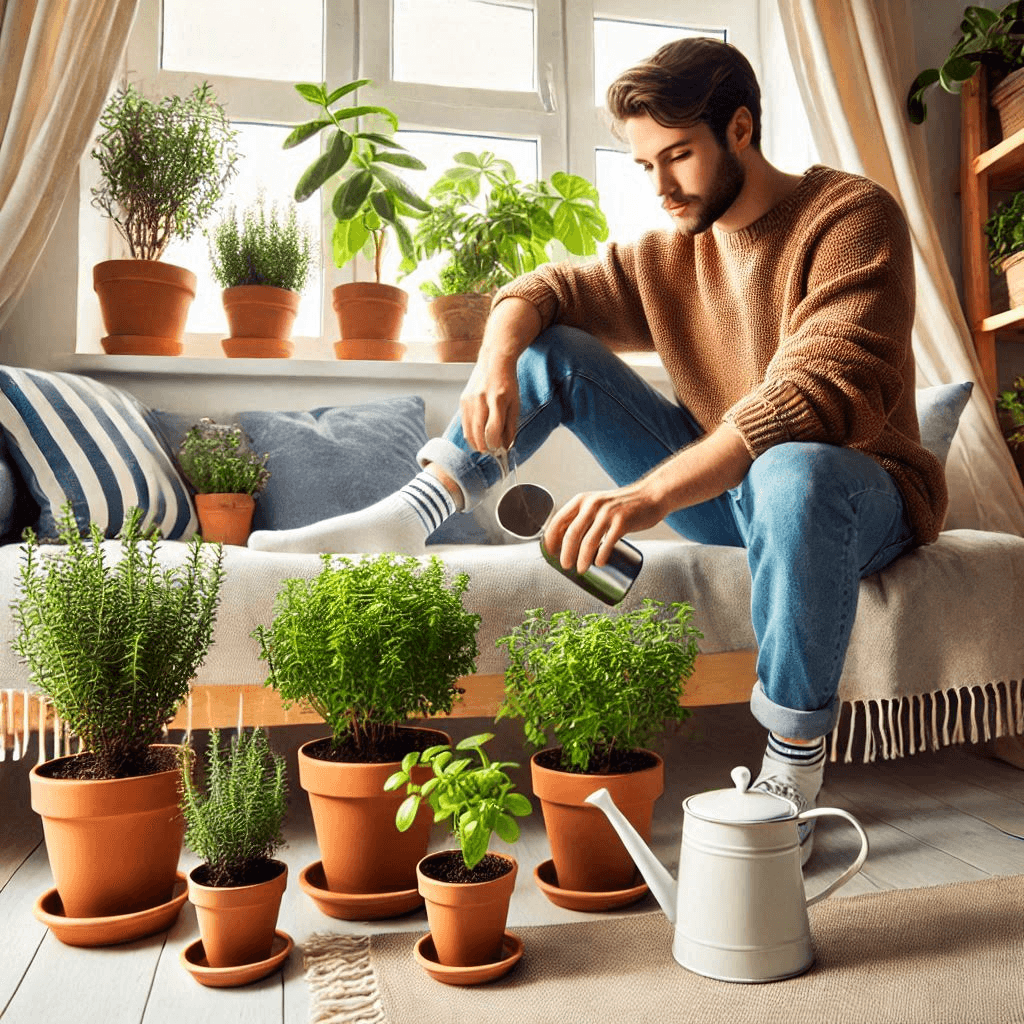Growing herbs indoors is a rewarding hobby that offers numerous benefits, such as providing fresh ingredients for your meals and enhancing your living space with greenery. Whether you’re a beginner or experienced gardener, growing herbs indoors is simple and accessible.
In this guide, we will cover the basics of starting an indoor herb garden, from selecting the right herbs to providing the best care, ensuring your herbs thrive all year round.
Why Grow Herbs Indoors?
There are many reasons to grow herbs indoors, making them an excellent choice for gardeners of all levels.
Fresh Herbs Anytime
Indoor herb gardens provide fresh herbs whenever you need them. By growing herbs at home, you can easily add flavor to your dishes without worrying about store-bought herbs wilting or spoiling.
Health and Wellness Benefits
Caring for plants, including herbs, can improve mental health by reducing stress and boosting mood. In addition, many herbs purify the air, contributing to a healthier indoor environment.
Fits Any Space
Even if you live in a small apartment or house, you can grow herbs indoors. Whether on a windowsill or countertop, most herbs only need a small amount of space to thrive, making them perfect for any home.
Choosing the Right Herbs

Choosing the right herbs for your indoor garden is key to success. Some herbs are easier to grow indoors, while others may require more care. Consider your available space, light conditions, and cooking preferences when selecting herbs.
Beginner-Friendly Herbs
For beginners, it’s best to start with herbs that are easy to grow. Herbs like basil, mint, and parsley are low-maintenance and adapt well to indoor conditions, making them ideal for first-time gardeners.
Herbs Based on Your Needs
Think about the herbs you use most in your cooking. Culinary herbs like rosemary, thyme, and oregano are perfect for savory dishes. If you’re looking to make tea, consider herbs like chamomile or lemon balm.
Consider Light and Climate
Different herbs have different light needs. Most herbs require at least 6 hours of sunlight daily. Herbs like basil, parsley, and cilantro thrive in full sunlight, while mint and chives can tolerate lower light levels. Keep your home’s temperature in mind—herbs generally prefer temperatures between 60-75°F (15-24°C).
Setting Up Your Indoor Herb Garden
Setting up your indoor herb garden is simple but requires some basic planning to ensure your plants thrive.
Picking the Right Containers
Choose containers with drainage holes to prevent water from pooling at the bottom, which can lead to root rot. Clay or terracotta pots are ideal because they allow the soil to breathe and help prevent overwatering. Make sure the pots are large enough for your herbs’ roots to grow comfortably.
Choosing the Best Location
Herbs need plenty of light to grow well. A south-facing windowsill is the best location for most herbs, as it gets the most sunlight. If your home doesn’t get enough natural light, you can supplement with grow lights to give your plants the light they need.
Soil and Fertilizer Tips
Use well-draining potting soil designed for indoor plants. Avoid garden soil, as it can become compacted in containers. Organic fertilizers can be used to feed your herbs, but don’t overdo it—too much fertilizer can result in overly fast growth and less flavor. Herbs generally need only a small amount of fertilizer every few weeks.
Watering Guidelines
Water your herbs when the top inch of soil feels dry. Overwatering can lead to root rot, so ensure your containers have proper drainage. Reduce watering in the winter months when plant growth slows down. Be mindful of each herb’s specific needs, as some require more water than others.
How to Care for Indoor Herbs
Once your herbs are planted, regular care is essential for healthy growth.
Light Requirements
Herbs need 6-8 hours of sunlight per day. Place your herbs in a spot where they can get the most sunlight, such as a south-facing window. Rotate the pots regularly to ensure all sides of the plants get light. If natural light is insufficient, you can use artificial grow lights to supplement it.
Pruning and Harvesting
Pruning your herbs regularly helps them grow fuller and healthier. Pinch off the tips of the stems to encourage branching and prevent your herbs from becoming leggy. When harvesting, only remove a few leaves at a time to avoid damaging the plant. Regular harvesting encourages new growth and keeps your herbs fresh.
Preventing Common Problems
Indoor herbs can encounter problems like pests, mold, or yellowing leaves. If you spot aphids or spider mites, treat your herbs with neem oil or insecticidal soap. Mold can be prevented by ensuring proper air circulation and avoiding overwatering. Yellowing leaves may indicate a lack of light or excessive watering.
Creative Ideas for Using Your Herbs
Once your herbs are thriving, you can use them in a variety of creative ways.
Cooking with Fresh Herbs
Fresh herbs enhance the flavor of many dishes. Use basil in pasta sauces, rosemary on roasted meats, and mint in drinks or desserts. Fresh herbs can transform the taste of your meals, making them more vibrant and delicious.
DIY Herbal Projects
Herbs can be used in various DIY projects. Make homemade herbal teas using chamomile, mint, or lavender. You can also create infused oils with rosemary or garlic, perfect for adding flavor to cooking or as a natural remedy for dry skin.
Decorating with Herbs
Herbs not only add flavor but also make beautiful decorative elements in your home. Arrange potted herbs on windowsills, counters, or shelves. You can also create small bundles of dried herbs like thyme or rosemary for a rustic and fragrant touch to your home décor.
Conclusion
Growing herbs indoors is a rewarding and enjoyable hobby. With the right care and attention, you can easily grow fresh herbs in your home, no matter the season. Whether for cooking, DIY projects, or decoration, your indoor herb garden will offer both beauty and practicality. Start growing your herbs today and enjoy the many benefits they bring!




